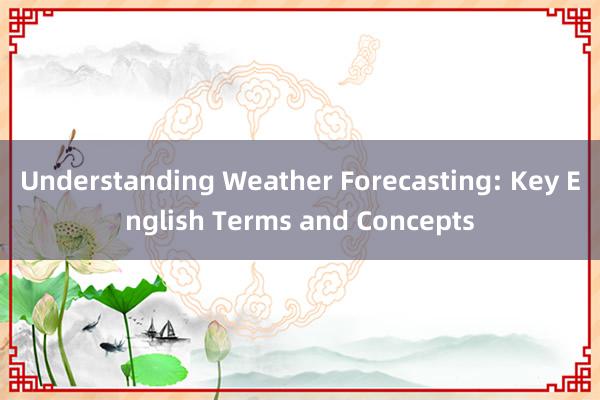Understanding Weather Forecasting: Key English Terms and Concepts
- 发布日期:2024-11-02 16:25 点击次数:104

### Understanding Weather Forecasting: Key English Terms and Concepts
Weather forecasting is a critical science that aims to predict atmospheric conditions for the future. This process involves a series of complex calculations and observations, utilizing various terms and concepts in meteorology. Understanding these terms is crucial for anyone interested in the field, whether as a professional or an enthusiast.
#### 1. **Atmospheric Pressure**
Atmospheric pressure refers to the weight of the air above a given point on Earth's surface. It is measured in units like Pascals (Pa) or millibars (mb). High-pressure systems typically bring clear skies and calm weather, while low-pressure systems can lead to stormy conditions.
#### 2. **Temperature**
Temperature measures the average kinetic energy of particles in a substance. In weather forecasting, it's essential to understand temperature gradients and how they affect the movement of air masses. Cold fronts, for example, occur when cold air moves into warmer air, often leading to changes in weather.
#### 3. **Humidity**
Humidity describes the amount of water vapor in the air. It is expressed as a percentage, with higher percentages indicating more moisture. Understanding humidity levels helps predict the likelihood of precipitation and the potential for thunderstorms.
#### 4. **Wind Direction and Speed**
Wind direction is measured from the direction from which the wind is blowing, typically described using points of the compass (e.g., N, NE, E, etc.). Wind speed is the rate at which the wind is moving, measured in units like meters per second (m/s) or kilometers per hour (km/h). These factors are crucial in determining weather patterns and the movement of air masses.
#### 5. **Barometric Pressure Trends**
Changes in barometric pressure can indicate approaching weather systems. A falling barometer suggests a low-pressure system is moving in, potentially leading to storms. Conversely, rising barometers indicate high-pressure systems, often associated with fair weather.
#### 6. **Precipitation Types**
Different types of precipitation include rain,海口市飞之锐网络科技有限公司 snow, sleet, and hail. Each type is influenced by temperature and humidity conditions, playing a significant role in weather forecasts. For instance, warm fronts usually bring rain, while cold fronts are associated with snow or sleet.
#### 7. **Fronts**
Weather fronts are boundaries between different air masses. Cold fronts occur when a cold air mass replaces a warm one, often leading to cooler temperatures and potentially severe weather. Warm fronts are when a warm air mass pushes past a cold one, usually resulting in milder weather conditions.
#### 8. **Cloud Types**
Clouds are formed when water vapor condenses into liquid droplets or ice crystals. Different cloud types—such as cumulus, stratus, cirrus, and nimbostratus—indicate varying weather conditions. For example, cumulonimbus clouds are associated with thunderstorms.
#### 9. **Satellite Imagery**
Modern weather forecasting heavily relies on satellite imagery to monitor cloud cover, temperature patterns, and other atmospheric phenomena. Satellites provide a global perspective, helping meteorologists track weather systems across vast distances.
#### 10. **Numerical Weather Prediction (NWP) Models**
NWP models use complex mathematical algorithms to simulate the Earth's atmosphere. By inputting current weather data, these models can predict future conditions with increasing accuracy. They are fundamental tools in modern weather forecasting.
Understanding these key terms and concepts is foundational to grasping the intricacies of weather forecasting. Whether you're tuning into the local news for daily updates or delving deeper into the science behind meteorology, this vocabulary provides a framework for interpreting weather predictions and the underlying atmospheric processes.
